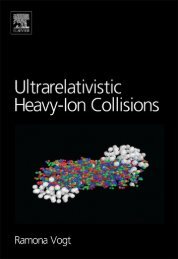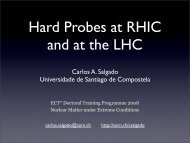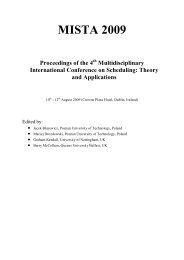Advances in perturbative thermal field theory - Ultra-relativistic ...
Advances in perturbative thermal field theory - Ultra-relativistic ...
Advances in perturbative thermal field theory - Ultra-relativistic ...
Create successful ePaper yourself
Turn your PDF publications into a flip-book with our unique Google optimized e-Paper software.
Thermal <strong>field</strong> <strong>theory</strong> 381<br />
gauge-<strong>in</strong>dependent location of the branch cuts at ω =±|k|, result<strong>in</strong>g <strong>in</strong> power-law relaxation<br />
of perturbations [220]. There is also an exponential component of Landau damp<strong>in</strong>g due to<br />
a pole at purely imag<strong>in</strong>ary ω and real |k| on the unphysical sheet reached by cont<strong>in</strong>uation<br />
through the branch cut between ω =±|k| [221].<br />
√<br />
k 2 = iκ<br />
For real ω< ˆω pl , there are no poles for real |k| but <strong>in</strong>stead for imag<strong>in</strong>ary<br />
correspond<strong>in</strong>g to exponential (dynamical) screen<strong>in</strong>g of (time-dependent) external sources.<br />
These poles, displayed on the left part of figure 9, are <strong>in</strong> fact closely related to the just mentioned<br />
poles at purely imag<strong>in</strong>ary ω and real |k|.<br />
In the static limit ω → 0, only mode B is screened with (Debye) screen<strong>in</strong>g length ˆm −1<br />
D .<br />
This corresponds to exponential screen<strong>in</strong>g of (chromo-)electrostatic <strong>field</strong>s. The transverse<br />
mode A on the other hand is only weakly screened when ω ≪ m D with a frequency-dependent<br />
<strong>in</strong>verse screen<strong>in</strong>g length [217]:<br />
( πm<br />
2<br />
) 1/3<br />
κ A ≃ D ω<br />
, ω ≪ m D . (5.19)<br />
4<br />
When ω → 0, mode A describes magnetostatic <strong>field</strong>s that are found to be completely<br />
unscreened <strong>in</strong> the HTL approximation. In QED the absence of magnetic screen<strong>in</strong>g is <strong>in</strong>tuitively<br />
clear and can be proved rigorously to all orders of perturbation <strong>theory</strong> [215,222] but not <strong>in</strong> the<br />
non-Abelian case.<br />
In QCD, the absence of a magnetostatic screen<strong>in</strong>g mass causes problems for perturbation<br />
<strong>theory</strong> as will be discussed further <strong>in</strong> section 7.4. In fact, lattice simulations of gauge-fixed<br />
propagators <strong>in</strong> non-Abelian theories do f<strong>in</strong>d a screen<strong>in</strong>g behaviour <strong>in</strong> the transverse sector,<br />
though the correspond<strong>in</strong>g s<strong>in</strong>gularity is evidently quite different from a simple pole [223].<br />
5.2. Fermions<br />
The fermion self-energy at non-zero temperature or density has one more structure function than<br />
usually. In the ultra<strong>relativistic</strong> limit where masses can be neglected, it can be parametrized by<br />
(ω,k) = a(ω,|k|)γ 0 + b(ω, |k|)ˆk · γ. (5.20)<br />
(For a massive fermion, this would also <strong>in</strong>clude a mass correction, i.e. = aγ 0 + bˆk · γ + c1.)<br />
This can be rewritten as<br />
γ 0 (ω,k) = + (ω, |k|) + (ˆk) − − (ω, |k|) − (ˆk), (5.21)<br />
where ± ≡ b ± a and the sp<strong>in</strong> matrices<br />
± (ˆk) ≡ 1 ± γ 0 γ · ˆk<br />
(5.22)<br />
2<br />
project onto sp<strong>in</strong>ors whose chirality is equal ( + ), or opposite ( − ), to their helicity. Dyson’s<br />
equation, S −1 =−̸k + , then implies<br />
γ 0 S −1 = −1<br />
+ + + −1<br />
− − (5.23)<br />
with −1<br />
± ≡−[ω ∓ (|k| + ± )]. This is trivially <strong>in</strong>verted to yield the fermion propagator<br />
Sγ 0 = + + + − − , (5.24)<br />
whose s<strong>in</strong>gularities are conveniently summarized by the equation<br />
det S −1 (ω, k) = 0, (5.25)<br />
where the determ<strong>in</strong>ant refers to sp<strong>in</strong>or <strong>in</strong>dices. The potential gauge dependences of the<br />
s<strong>in</strong>gularities of S are described by an identity of the form [192]<br />
δ det S −1 (ω, k) = det S −1 (ω, k) δtrX(ω,k), (5.26)







